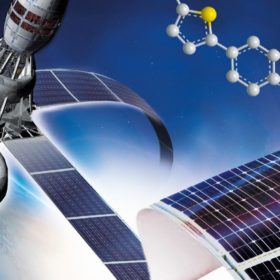
Scientists at Russia’s Skoltech Institute of Science and Technology have demonstrated a solar cell with record high radiation stability. The scientists say the cells, based on an organic polymer compound, could be a strong candidate to meet the requirements of powering satellites in lower earth orbit.
A team led by the Skolkovo Institute of Science and Technology (Skoltech) in Moscow has demonstrated an organic solar cell able to withstand 6,000 gray units (Gy) of gamma radiation, an achievement the institute says is a record high.
The performance raises hopes the cell could power satellites in near-earth orbit, where the researchers theorized the device could deliver operational lifetimes well beyond 10 years.
The cells are described in the paper Impressive Radiation Stability of Organic Solar Cells Based on Fullerene Derivatives and Carbazole-Containing Conjugated Polymers, published in ACS Applied Materials & Interfaces. The devices are based on a blend of carbazole-based polymers and a fullerene derivative.
Testing showed a composite film of those materials maintained more than 80% of its initial conversion efficiency after exposure to a maximum absorbed dose of 6,500 Gy. The researchers noted, NASA estimates satellites in geocentric Earth orbit are exposed to an average annual radiation dose of 160 Gy, making the organic compound tested by the Skoltech team a strong candidate to operate effectively in such an environment for more than a decade.
Other pluses
The paper noted further advantages of using organic PV for satellite applications, including a high power to weight ratio, and flexibility. “Deploying space solar sails made of flexible plastic solar cells represents an enticing opportunity for ramping up the power of photoelectric converters on the satellites,” said Skoltech professor Pavel Troshin, who led the research group.
The same group recently evaluated a group of lead based perovskites for similar applications and found the cells quickly degraded under exposure to 5,000 Gy of radiation. A Chinese research group, meanwhile, discovered the lack of moisture in oxygen 35km from the Earth’s surface played to perovskite’s advantage.
Satellites requiring an energy source in space have mostly relied on III-V solar cells – so named because they incorporate elements from those groups of the periodic table. Alternative concepts such as organic PV and perovskites, however, potentially offer a much cheaper alternative.
Lắp đặt điện mặt trời Khải Minh Tech
https://ift.tt/2X7bF6x
0906633505
info.khaiminhtech@gmail.com
80/39 Trần Quang Diệu, Phường 14, Quận 3
Lắp đặt điện mặt trời Khải Minh Tech
https://ift.tt/2ZH4TRU
Không có nhận xét nào:
Đăng nhận xét